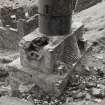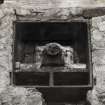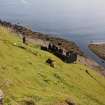Skye, Inver Tote, Diatomite Works
Diatomite Works (19th Century)
Site Name Skye, Inver Tote, Diatomite Works
Classification Diatomite Works (19th Century)
Canmore ID 191593
Site Number NG56SW 21
NGR NG 52022 60498
NGR Description Centred NG 52022 60498
Datum OSGB36 - NGR
Permalink http://canmore.org.uk/site/191593
- Council Highland
- Parish Kilmuir
- Former Region Highland
- Former District Skye And Lochalsh
- Former County Inverness-shire
NG56SW 21.00 5214 6051
See also NG45NE 1 and incorporates information from cancelled site NG56SW 26
NG56SW 21.01 NG 5201 6049 Chimney Stack; Building
NG56SW 21.02 NG 5200 6040 House
NG56SW 21.03 NG 518 605 Quarry
The former diatomite mine and works at Inver Tote sit in the parishes of Kilmuir, to the North and Snizort, to the South. The Lealt River acts as the boundary between the two parishes at this point.
Information from RCAHMS (DHR), July 2001.
See NG45NE 1 for the Diatomite Works at Loch Cuithir.
Information from RCAHMS (DHR), July 2001.
Diatomite is a white or grey mineral earth which has similiarities to china clay. It is formed from deposits of living the skeletons, shields or shells of fresh water minute microscopic organisms or diatoms. Diatomite can be used for insulation against sound and the loss of heat and cold. It is also a useful material for fireproofing.
Information from Diamomite and its Uses, published by the British Diatomite Co. Ltd., Glasgow, see MS/1077/17.
Diatomite is silica-rish sediment formed by microscopic algae, and has many uses, such as face powder, fire-proofing and insulation, neutral filler, and as a filter in several industrial processes. However, one of the greatest causes of interest in Skye Diatomite was its potential use as a substitute for Kieselghur by Alfred Nobel in the production of Dynamite in Nobel's new Scottish factory at Ardeer in Ayrshire during the 1880s.
Nobel eventually found a better source of material, but the Extraction of Diatomite nevertheless began in Skye at Loch Cuithir in 1886. The Diatomite was transported by tramway to be processed at Invertote, production continuing until 1913. The industry was briefly revived between 1950 and 1961, using road transport.
The principal remains of the Invertote works are a large, rubble-built, rectangular-plan roofless building (NG5201 6049). It has been entirely gutted, but fragmentary remains include a large cast-iron flywheel from a steam engine, and a cast-iron wall-mounted bearing box. The other surviving structure is a kiln (NG5201 6052), comprising a lower chanber or firebox built from Scottish firebricks (produced at the Star Works, Glenboig, Lanarkshire, and Etna Works, Armadale, West Lothian), onto which has been constructed a circular-section fireclay-brick column encased by an outer layer of sheet steel. The exact functions of the processing building and the kiln are uncertain, but it is likely that the latter was used for drying purposes.
Information from RCAHMS (MKO) 1994






































































